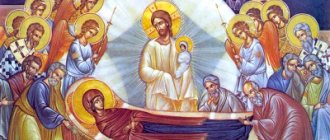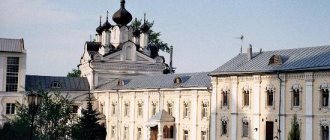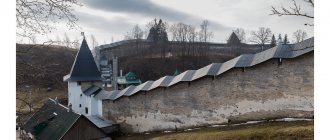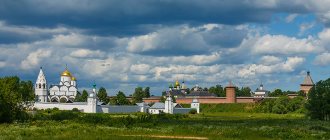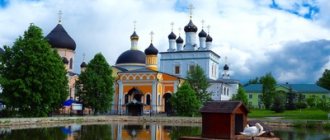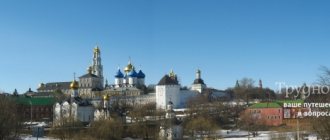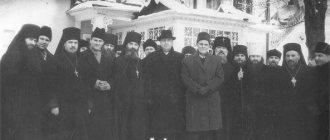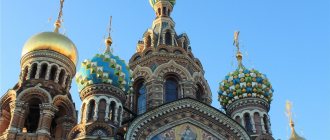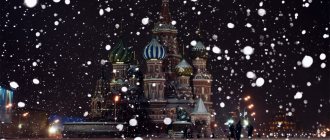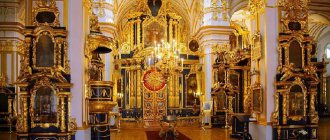[Show]
- Source (source) Auliya
- Holy spring in the village of Kolotskoye
- Talezh holy spring
- Gremyachiy Key Spring
- Arkhangelsk spring near the village of Sosnovka
- Temple and holy spring near the village of Newest Pichuri
- Temple and holy spring near the village of Ivashchenkovo
April 22 is considered the day of opening of the springs (the popular name is Vadim the Klyuchnik). There are so many springs in Russia that it is not possible to count their exact number. We will tell you about 7 holy springs, which, if you wish, you can visit on these April days.
A source, source, or key is denoted by a small aqua stream that flows directly from the bowels of the earth. Any source is a unique natural body of water. It is impossible not to find out the taste of cold spring water - it is special, soft, unsullied, alive. Magical. After all, such water reaches us in its original form, natural in its own hydrochemical composition. Spring water from a proven source does not need to be further purified. During its journey from the depths of the earth to the surface, it passes through natural filters - gravel and sand. Some of the springs are popularly considered holy springs. Powerful in places.
Holy springs can be both pagan and Christian. Usually, each such place has a legend associated with it. Christian legends are usually associated with the name of a saint, while pagan legends are associated with the presence of a guardian spirit or other natural essence at the source. We will tell you about 7 more recognizable holy springs that we recommend visiting.
Source (source) Auliya
The Aulia source is located in the Republic of Bashkiria, near Mount Aushtau. Aulia is translated from Bashkir as “saint”. This spring flows only 30 days a year. And very soon you will have the opportunity to see this magic, because its waters appear from underground in May. People who visit Aulia (and there are many of them, tens of thousands a year) believe that its water is healing. It can relieve kidney stones, cure almost all respiratory diseases and stomach diseases. Locals say that the water becomes healing only after May 15th.
Kirillo-Belozersky Monastery
It is located in the city of Kozelsk, Vologda region and is recognized as the largest monastery in Europe.
The monastery, named after its founder Cyril, arose at the end of the 14th century among impenetrable forests on the shores of Lake Siverskoye in a series of other monasteries and deserts (among them the neighboring monasteries of Ferapontov, Sergievsky and Goritsky, Nilo-Sora Hermitage), developed on annexed lands. Settlements arose around the monastic hermitages, which over time turned into cities.
There have been many trials that befell the monastic brethren over seven centuries: raids from neighboring countries trying to capture and destroy the islands of Orthodoxy.
The monastery was not surrounded by royal favor and financial support: Peter I, Ivan the Terrible, Alexander I, who visited the Northern Lavra, allocated a lot of money for its improvement, which made it possible to build beautiful churches, many of which are striking in their beauty even today.
The monastery is impressive with the size of the territory and the thickness of the walls: 11 meters high and 7 meters thick. The main temple is the Assumption Cathedral, built of stone on the site of a burnt wooden one and marking the beginning of the stone buildings of the monastery.
Since 1924, a museum-reserve has been operating on the territory of the monastery, which has collected priceless exhibits about the history of the monastery and the Vologda region.
Holy spring in the village of Kolotskoye
On the site of the Assumption Kolotsky Nunnery, in the Moscow region, there is a source with the most delicious sweetish water. This monastery is famous for the miraculous icon of the Mother of God, revealed in 1413. Before the revolution, the icon was kept in the monastery, and pilgrims and pilgrims came to it. The holy spring has been known since the same times. In Russian times, the icon was transported from the monastery - the last traces of it were discovered in Gzhatsk (now Gagarin). They tried to bury the source more than once, but the space of power turned out to be beyond the control of bureaucracy. Locals cleared the source every time, believing in its power and miracle. In our time, the Kolotsky monastery has been revived as a ladies' monastery (before the revolution it was male), and a beautiful wooden chapel was erected above the source.
Excerpt describing the Sacred Spring
At the sight of a strange city with unprecedented forms of extraordinary architecture, Napoleon experienced that somewhat envious and restless curiosity that people experience when they see the forms of an alien life that does not know about them. Obviously, this city lived with all the forces of its life. By those indefinable signs by which at a long distance a living body is unmistakably distinguished from a dead one. Napoleon from Poklonnaya Hill saw the flutter of life in the city and felt, as it were, the breath of this large and beautiful body. – Cette ville Asiatique aux innombrables eglises, Moscow la sainte. La voila donc enfin, cette fameuse ville! Il etait temps, [This Asian city with countless churches, Moscow, their holy Moscow! Here it is, finally, this famous city! It's time!] - said Napoleon and, dismounting from his horse, ordered the plan of this Moscou to be laid out in front of him and called the translator Lelorgne d'Ideville. “Une ville occupee par l'ennemi ressemble a une fille qui a perdu son honneur, [A city occupied by the enemy is like a girl who has lost her virginity.] - he thought (as he said this to Tuchkov in Smolensk). And from this point of view, he looked at the oriental beauty lying in front of him, whom he had never seen before. It was strange to him that his long-standing desire, which seemed impossible to him, had finally come true. In the clear morning light he looked first at the city, then at the plan, checking the details of this city, and the certainty of possession excited and terrified him. “But how could it be otherwise? - he thought. - Here it is, this capital, at my feet, awaiting its fate. Where is Alexander now and what does he think? Strange, beautiful, majestic city! And strange and majestic this minute! In what light do I appear to them? - he thought about his troops. “Here it is, the reward for all these people of little faith,” he thought, looking around at those close to him and at the troops approaching and forming. – One word of mine, one movement of my hand, and this ancient capital of des Czars perished. Mais ma clemence est toujours prompte a descendre sur les vaincus. [kings. But my mercy is always ready to descend to the vanquished.] I must be generous and truly great. But no, it’s not true that I’m in Moscow, it suddenly occurred to him. “However, here she lies at my feet, playing and trembling with golden domes and crosses in the rays of the sun. But I will spare her. On the ancient monuments of barbarism and despotism I will write great words of justice and mercy... Alexander will understand this most painfully, I know him. (It seemed to Napoleon that the main significance of what was happening lay in his personal struggle with Alexander.) From the heights of the Kremlin - yes, this is the Kremlin, yes - I will give them the laws of justice, I will show them the meaning of true civilization, I will force generations the boyars lovingly remember the name of their conqueror. I will tell the deputation that I did not and do not want war; that I waged war only against the false policy of their court, that I love and respect Alexander, and that I will accept peace terms in Moscow worthy of me and my peoples. I do not want to take advantage of the happiness of war to humiliate the respected sovereign. Boyars - I will tell them: I do not want war, but I want peace and prosperity for all my subjects. However, I know that their presence will inspire me, and I will tell them as I always say: clearly, solemnly and grandly. But is it really true that I am in Moscow? Yes, here she is! “Qu'on m'amene les boyards, [Bring the boyars.],” he addressed the retinue. The general with a brilliant retinue immediately galloped after the boyars. Two hours passed. Napoleon had breakfast and again stood in the same place on Poklonnaya Hill, awaiting the deputation. His speech to the boyars was already clearly formed in his imagination. This speech was full of dignity and the greatness that Napoleon understood.
Talezh holy spring
Approximately 70 kilometers from Moscow, not far from the town of Chekhov, there is the village of Talezh, lost among beautiful forests. It is there that the courtyard of the Ascension David’s Hermitage is located. In its area there is a spring with unusually tasty and healing holy water. You will pass through a beautiful gate crowned with forged roses and go down a long staircase to clear, icy water. You can simply take some water and appreciate its sweet taste. Or you can go into the font (there are both women’s and men’s fonts on the site) and plunge into the magical water of the source three times. Above the source there is a chapel in the name of the “Life-Giving Spring” icon.
Gremyachiy Key Spring
Not far from the village of Vzglyadnevo, on the right bank of the small river Vondigi, the Gremyachiy Klyuch spring gushes out of the ground. It is believed that the source did not exist here constantly - it was activated by the prayer of Sergius of Radonezh himself. There may be some inconvenience associated with visiting this source. Firstly, this source is constantly crowded with pilgrims and tourists. Secondly, the road leading to it is quite washed out, which is difficult to drive in bad weather. But it’s worth it - as soon as you plunge into the icy green clear water, all the problems of the difficult path will be forgotten.
Typology of Sardinian sacred springs
1. “Cyclopean wall”: The structure consists of sandstone slabs roughly fitted to each other.
2 “Wall of the Opus isodomum type”: The stones, processed and laid out in even layers, present a good and symmetrical structure.
3. “Polygonal walls”: Polygonal walls form a very complex structure that requires extraordinary skill.
The most well-preserved (including restored) ancient “sacred springs” include: Sa Testa and Milis in Olbia, Predio Canopoli near Perfugas, the hypogeum of San Salvatore near Cabras, Santa Anastasia near Sardara, Santa Cristina near Paulilatino, Santa Vittoria, Sos Nurattolos near Budduso and Serra Niedda near Sorso. Some of these religious buildings have modern names, which is associated with their subsequent use in Christian worship. Another sacred spring, next to which there is a tomb of giants and a round temple (Capanna circolare), is located near the Noddule nuragha, Bitti.
Arkhangelsk spring near the village of Sosnovka
In the Penza region of Russia, in the Bashmakovsky district, on the banks of the Ushinka River, there is a small village of Sosnovka. These places have a rich and long history. This village was founded in the first half of the 18th century by Prince Misha Larionovich Kugushev. In 1855, a stone Church of the Intercession of the Blessed Virgin Mary was built here, which has not survived to this day. At the moment, a large worship cross has been erected on the site of the destroyed temple. There is also a revered source - any local will give you a hint on how to get to it. The temple has not survived to this day.
Solovetsky Monastery
Located on the Solovetsky Islands in the White Sea, the monastery - a 5-cornered Kremlin - is associated with a fortress: high - up to 11 meters - walls 5 meters thick with towers-loopholes in the corners. It had the status of a fortress: already in the 16th century, in addition to monks, troops were stationed here to repel attacks by neighbors trying to enter the country from the north.
The history of the monastery is rich in events. For several centuries it was a place of exile for church and government officials disliked by the rulers.
This is interesting: the future Patriarch Nikon took monastic vows at the Solovetsky Monastery, but, having come into conflict with Elder Eleazar, he fled. The monks of the monastery did not accept his church reform and condemned it as heresy. The confrontation, called the Solovetsky seat, lasted eight years, and ended with the capture of the fortress only because of the betrayal of one of the monks.
Now the monastery has been restored, and the Solovetsky State Historical, Architectural and Natural Museum-Reserve operates here.
The beauty of northern nature, the architectural uniqueness of the monastery, and the special atmosphere of the island attract pilgrims, tourists, and archaeologists.
Temple and holy spring near the village of Newest Pichuri
The next holy spring, which we want to tell you about, is located in the Mordovian village of Newest Pichuri. In 1839, at the expense of nobleman Pavel Ivanovich Sokolov and parishioners, a stone two-altar church was built here. It has survived to this day, although it is in need of restoration. But in 1945, the believers of the village of Newest Pichuri, with their own efforts, built a wooden prayer house, consecrated in honor of the Dormition of the Blessed Virgin Mary. The holy spring, which is located in New Pichuri, has a popular name - Ponik-spring. It was mentioned for the first time in 1742. There is a legend that the icon of John the Baptist was revealed here. In 1993, the holy spring was enclosed in a log house and a chapel was built above it, and a gazebo was built nearby. The water comes out of the ground, and after a few meters it goes back into the ground, “dragging.” Perhaps that is why it is called Ponik-Spring?
Text of the book “Miraculous Orthodox Springs of Russia”
On the land of Stefan of Perm
On the territory of the Komi Republic, in those areas where the Zyryan enlightener Stefan of Perm preached Christianity several centuries ago, there are many well-known sources revered by the people.
In the old days, many of them were adjacent to churches or chapels. Thus, a spring with healing water named after Saint Paraskeva was located near the temple consecrated in honor of this great martyr, near the Sysola River. Another famous key was named in honor of a highly revered saint in Ukraine - Theodosius of Chernigov, who lived in the 17th century. The source is known for the healings that occurred from its water (and some facts date back to relatively recent times).
Well of Blessed Euphrosyne
One of the most famous miraculous springs in the Tula region is named after the blessed elder Euphrosyne, a contemporary of Catherine II. Near the cross erected at the holy spring there is an inscription: “Take water from my well and be healthy.” And local residents still remember how the hundred-year-old Euphrosyne dug this well herself.
The fate of Saint Euphrosyne is amazing. A representative of an ancient princely family, Evdokia Vyazemskaya was educated at the Smolny Institute for Noble Maidens, then was a maid of honor to Empress Catherine II. Dissatisfied with the vanity of court life, she and two of her friends secretly left Tsarskoye Selo. Then, with the blessing of the Metropolitan, to whom she turned for advice and spiritual guidance, she was tonsured a nun with the name Euphrosyne and accepted the difficult feat of foolishness.
For several decades, the ascetic lived in a squalid dwelling near the walls of the Serpukhov women's monastic monastery. Then she lived near the ancient city of Aleksin, in the village of Kolyupanovo, where she found a spring with miraculous powers. In total, the old woman lived for more than a century – from 1735 to 1855.
According to this vow, Blessed Euphrosyne acted as a fool. For example, when, by order of the landowner, a hut was cut down for her, she installed a cow there, and she continued to live in a miserable shack. The princess, who knew the French language and court etiquette perfectly, did not disdain the hardest work.
However, in reality, the old woman has not at all lost the ability to sensibly perceive the world around her. In addition, she possessed the gift of prophecy.
The source of the holy old woman turned out to be miraculous. Already during Euphrosyne’s lifetime, many pilgrims received healing from various ailments using its water. Subsequently, a bathhouse was built at the source.
The holy spring of Blessed Euphrosyne still exists. It is well known to pilgrims and is visited by many pilgrims. There are two bathhouses near the well, and water flows to them through three pipes. Healings still happen here. Moreover, it is believed that the holy water of the source of Blessed Euphrosyne is especially helpful in the treatment of malignant tumors and blindness.
So, already in our days, an amazing healing of a blind boy took place at the spring. “The Pilgrim’s Guide to the Holy Places of Rus'” reports the following about this:
“After the prayer service of Blessed Euphrosyne, served in the monastery, the parents brought the blind child to the source, wiped the child’s face three times, and then the boy plunged into the waters of the source three times - and received his sight.”
Springs of the Arsky Forest
In the Ulyanovsk region, not far from the Epiphany Church and the Church of Blessed Xenia of Petersburg in Arskoye, there are two amazing springs.
The first spring is dedicated to St. Nicholas the Wonderworker. It is located in the Arsk forest on a hillside. Water gushing from underground fills the depression, forming a small lake. Nowadays, this source, revered by the people, was consecrated, a cross was installed near it and a font was built. According to a long-standing tradition, prayers are held at the source on certain days.
The water of the Nikolsky spring is considered healing, and therefore the spring is visited by pilgrims from all over the area. There have already been several cases of people being delivered from various mental and physical ailments. And more than half a century ago, no less amazing events took place at this place: as local residents reported, apparitions of the wonderworker Nicholas of Myra himself repeatedly took place here. Therefore, the fontanel that came out of the ground was named after the saint.
Then, for a long time, people came to the forest spring at the foot of the hill not only to get spring water, but also for the sake of solitary prayer to one of the most revered saints by the Orthodox people. After all, Archbishop Nicholas of Myra, according to his life, was distinguished not only by his righteous life and persistent confession of faith. He also saved people from poverty and stood up for the offended and unjustly convicted. Witnesses of mysterious visions also told how the miracle worker who appeared to them helped them with hard work or protected them from pursuers.
As for another source, formed by seven small springs, it was discovered quite recently - already at the beginning of the new millennium. This happened during the construction of a new church dedicated to the recently canonized Blessed Xenia of St. Petersburg. As you know, this ascetic lived in the 18th century. in the northern capital of Russia. After the death of her husband, who did not have time to repent of his sins before his death, Ksenia distributed her property to the poor and accepted the feat of foolishness. During her lifetime, this saint became famous for her gift of prophecy, and after her death for her miraculous help to many people who revere her memory.
Based on the name of the nearby temple, its key was named New Spring.
It is considered miraculous, and therefore there are fonts here for those who want to plunge into the spring water. And just like at the long-known holy springs, prayer services are performed near it.
On the blood of the slain
In the Penza region there are several miraculous springs, the emergence of which folk tradition dates back to those distant times when the inhabitants of the forest region were in danger from nomadic steppes.
This is the history of Semiklyuchye, located on the left bank of the Uza River - one of the most revered holy places by pilgrims.
Several centuries ago, a small monastic community existed in this forest region. But the monastery, lost in the forests, was still found by the nomads during their raid. They killed seven monks, and immediately streams of seven springs gushed out from under the ground.
Since then, the news has spread about the holiness of the Seven Springs, the sources of which miraculously appeared on the blood of the martyr.
Subsequently, the Tikhvin Icon of the Most Holy Theotokos was discovered at one of the springs, and pilgrims built a chapel there.
In the old days, Semiklyuchye was highly revered. Prayers were served at the source in the ninth week after Easter on Friday. Near the chapel and springs there were modest dwellings in which monks lived. Pilgrims arriving in Semiklyuchye from remote areas could also find temporary shelter here.
Under Soviet rule, the monastic community was expelled, and the shrines of Semiklyuchye were destroyed. Even the spring water, quite suitable for drinking or household needs, on the initiative of the authorities, repeatedly tried to spoil it by pouring gasoline into it. However, the pilgrims did not forget about the holy place and continued to visit it.
Now the springs have been cleared and a bathhouse has been built. And where the miraculous image of Tikhvin appeared, a cross was erected.
Another legend refers to the Nikolsky spring near the village of Russky Kachim.
In the 17th century, settlers from Central Russia lived in the forest on the Kachimka River.
Faced with the threat of an attack by nomads, these Christians hid the icon of St. Nicholas of Myra, which they revered. They themselves were killed, but the miraculous image survived. The icon, wrapped in canvas and covered in wax, was found many years later in a swampy area by Orthodox people. Whether this happened by chance when the mill was being built, or by a revelation received by a certain sick soldier (he was subsequently healed by the miraculous image), is now impossible to establish.
The source where the icon was found was called Nikolsky. In the old days there was a chapel there and the feast of the transfer of the relics of St. Nicholas the Wonderworker was especially revered (May 9, according to the new style - May 22).
Destroyed in the 30s. last century, the chapel has now been restored, the spring has been cleared, and its surroundings have been put in order.
Miraculous springs of the Russian capital
Holy springs or wells exist not only on the outskirts of small villages or within monastic monasteries far from noisy cities. At least 30 similar sources are known in the Russian capital, Moscow.
Moscow has long been famous for its golden-domed churches and ancient monasteries. The first Moscow prince known in history, Daniil
Alexandrovich, ended his earthly journey as a schema monk in a monastic monastery. He was subsequently canonized. The name of the youngest son of Alexander Nevsky is associated with the emergence of the oldest monastery in the city - St. Danilov, which was founded by the pious prince in 1282 and named in honor of his heavenly patron, the Venerable Daniel the Stylite.
On the territory of this monastery, which is now the spiritual and administrative center of the Russian Orthodox Church, one of the most famous miraculous springs in Moscow still exists.
Another holy spring is located in Fili, famous for the military council that took place there in 1812 and the magnificent Church of the Intercession, a wonderful monument of Russian architecture, built during the reign of Peter I.
Kolomenskoye, which is now located within the city, is especially famous for its healing springs, but in ancient times was a suburban village. The Kadochka spring, with the water of which other members of the family of Tsar Ivan IV were healed, flows near the Ascension Church crowned with a stone tent. In total, there are about 20 springs in Kolomenskoye.
In the Teply Stan area there is the so-called Cold Spring. To heal from diseases of the head, kidneys and liver, it is customary to drink its healing water twice a day - in the morning before meals and in the evening.
Near the Church of the Nativity of the Blessed Virgin Mary in the Tatar ravine another holy spring flows. Its water is distinguished by its extraordinary purity and also helps heal various ailments.
There are also miraculous springs in Serebryany Bor, Tsaritsyn, Neskuchny Sad, Kuntsevo - you can’t count them all.
Tikhvin spring near Usolye
Another spring, the veneration of which has recently been renewed, is located in the area of Usolye and Bereznyaki. There is a legend that the Tikhvin Icon of the Lady of Heaven once appeared here on the top of a mountain overgrown with forest. Although the miraculous image was found at a local source of clear spring water, it comes from the distant Kostroma land.
In ancient times, a stone chapel was erected above the spring. A religious procession was held here every year on the day of the celebration of the Tikhvin Icon. And a priest who came from nearby Usolye served in the chapel at the spring.
During Soviet times, the chapel was destroyed, and previous traditions were forgotten for a long time.
The situation changed only after the opening of a temple in Bereznyaki in the name of the Holy Forerunner and Baptist of the Lord John. Then the source was cleared and deepened, and a canopy was installed over it. It was even possible to find an ancient miraculous icon, although it was subsequently lost again.
Since the beginning of the 90s. XX century the good custom of religious processions to the sacred spring has been renewed. For this purpose, as before, a day has been set for the celebration of the Tikhvin Icon of the Most Holy Theotokos.
In the Saratov province
Some springs located in Saratov itself and other areas of the region have long been revered as saints.
For example, residents of the regional center are well aware of the St. Alekseevsky spring, which is located on the mountainside near the convent.
In the middle of the 19th century. here was the bishop's dacha, and a little later - the monastery of the nearby Spaso-Preobrazhensky Monastery. This area was called Upper Monastyrka.
After the revolution, the monastery was closed, and the Church of St. Alexius that existed on its territory was partially destroyed and rebuilt. Even the garden that adorned the area was damaged, and the spring was walled up. Various medical institutions were located on the site of the former monastic monastery.
The return of St. Alexei's monastery to believers occurred only in the early 90s. of the past century. A monastic community was created here, only now it was female. In 1997, the monastery received the status of a convent.
Simultaneously with the restoration of the temple and the improvement of the surrounding area, the spring was freed from long-term captivity. Saratov residents once again have the opportunity to collect clean and healthy water here. Some people come from far away for it. Nowadays, even rumors have spread about the holiness of the water of the monastery spring.
Pilgrims arriving from afar visit the spring in Vavilov Dolu (12 km from the regional center - the village of Ivanteevka). According to local legends, the robber Vavila once repented of his sins here. According to legend, the former sinner’s home was a cave dug in a deep ravine.
A stone chapel crowned with a tent over a spring in Vavilov Dolu stands against the backdrop of tall birch trees, surrounded by flower beds and well-groomed alleys. Now baths are being built at the spring, which will allow pilgrims to plunge into the waters of the spring at any time of the year.
The miraculous source White Key is located in the Voskresensky district near the village of Usovka. As was noted even in pre-revolutionary times, its water is purified by passing through layers of limestone, and therefore can be stored for a long time and not spoil. In addition, spring water does not freeze in the winter cold and remains cool in the summer heat.
Local legends indicate that an icon of the Holy Great Martyr Paraskeva Friday was once found at the spring. That’s why they built a chapel on the spring. Not only the inhabitants of nearby villages came to the White Key for life-giving water, but also pilgrims arriving from afar. Especially a lot of people gathered here on the days of memory of Saint Paraskeva.
The chapel, destroyed during Soviet times, was restored in the mid-90s. last century. Gradually, the spring itself was improved, again attracting pilgrims.
Another holy spring exists near the village of Nikolaevka in the Atkarsky district. This key breaks out of the ground on the slope of a deep ravine called Prayer Corner. The spring is surrounded by tall trees.
According to legend, the water of the spring received healing powers after pilgrims near it had a vision of a church that did not exist in reality. Small icons and wax candles began to be brought to the source. With faith in healing and prayer, people drank spring water. According to stories, in some cases even hopelessly ill people recovered.
One of the springs of the Saratov land is named in honor of the Kazan Icon of the Heavenly Intercessor. This source is located on the territory of the Romanovsky district.
According to local legend, the miraculous Kazan image of the Blessed Virgin Mary once took place here. That is why this source of clean cold water was especially revered. In the old days, residents of the area came here for holy water on the feast of Epiphany (January 19, new style).
Nowadays, the area adjacent to the spring has been landscaped. The source itself is enclosed in a log house, with a chapel with a bell and a bathhouse built next to it. In the summer of 2003, the consecration of the spring and chapel took place. About one and a half thousand people were present at this celebration.
Both miraculous and some other sources are known. For example, a spring located 6 km west of the city of Khvalynsk is called Saint. In the old days, near this forest spring there was a wooden cross. The pleasant-tasting water of the spring has long been revered as healing. Even in Soviet times, believers visited the Holy Spring and prayed near it. Currently, the famous Khvalyn spring is recognized as a natural monument. Recently, a cross was re-installed over it.
Revelation of Elder Praskovya
In the distant 17th century, the veneration of the Tikhvin spring, located near the city of Kerensk (now the village of Vadinsk), began.
A certain old woman Praskovya received a revelation in a dream that a chapel should be erected in the forest above this spring. An icon of the Mother of God was soon found at the indicated place.
The local governor Yakov Pykhachev was informed about the events that had taken place. At his command, the miraculously found image was transferred to the Epiphany Church. There was a guard of archers at the spring for several days, however, no miraculous phenomena or healings occurred during this time.
And yet, due to the growing number of pilgrims coming to the spring, two years later Patriarch Joachim ordered the founding of a women’s monastic monastery here. The main cathedral of the monastery was called Tikhvinsky, as was the spring famous for its miracles. Another church was consecrated in honor of the icon of the Mother of God “Life-Giving Source”.
With short interruptions, the Tikhvin Convent near Kerensk existed from 1683 to 1927.
It was customary to make a religious procession to the holy spring twice a year: on the days of the celebration of the Tikhvin Icon and the appearance of the miraculous image near the spring (June 26 and July 3, respectively). Several thousand parishioners and all the local clergy took part in these celebrations.
Evidence of miraculous healings with the water of the Tikhvin spring has been preserved. Thus, one city woman, during a serious illness, received relief after drinking the water of a life-giving spring. Soon the woman was completely healed of her illness.
The veneration of the Tikhvin spring by believers continued during Soviet times, although this, naturally, was not welcomed by the local authorities.
Finally, in the 90s. XX century near the walls of the Temple of the Life-Giving Spring, a well was again dug and consecrated. Soon the monastery was restored (only now it became a man’s monastery) and both monastery churches were restored. The miraculous spring was not forgotten either: services began to be performed over it again, and a copy of the Tikhvin icon was installed nearby and a bathhouse was built near the spring.
Springs of the Penza region
There are many miraculous springs in the Penza region. Many extraordinary events are associated with them.
For example, the Nikolsky spring near the village of Fedorovka became known in the last decade of the 18th century. Then the landowner E.P. Chemesov, the owner of Fedorovka, received a revelation in a dream to clear this source, which originates on the mountain north of the village. During the above work, a small image of St. Nicholas was found, carved on a stone. Having learned about what had happened, the landowner built at his own expense a stone chapel over the spring and a large stone church, into which the icon was subsequently transferred.
In the old days, many pilgrims from all nearby counties gathered in Fedorovka on the day of the patronal feast of the transfer of the relics of St. Nicholas of Myra (May 9, old style).
Now a well and a hipped roof topped with a cross have been built over the spring. The holy spring is surrounded by a small wooden fence.
No less mysterious stories are associated with other springs in the Kamensky region.
Thus, not long before the revolution, miracles occurred at a source located in a ravine near the village of Vladykina. The children of local peasants found an unusual image of the Mother of God there: it appeared on a petrified piece of chalk. The icon was brought to the parish church, and soon at least ten healings occurred after intense prayer and the use of life-giving water. The amazing events were noticed even by the governor and the bishop.
After the revolution, the icon disappeared. The source was still visited by pilgrims, especially in case of drought.
Several years ago a log house was built over the spring.
Folk legend dates back to the time of one of the Russian-Turkish wars the emergence of the miraculous spring of Gremyachka, east of the village of Malaya Serdoba.
They say that two peasant sons did not return from the war for a long time, and there was no news from them. Parents no longer hoped to see their children alive. And on the day of the Nativity of John the Baptist, the old father was picking mushrooms in the forest. He was given over to sad thoughts, prayed and cried bitterly. Where his tears fell to the ground, a source of cold spring water appeared.
When the old peasant came home, good news awaited him: his sons had finally returned alive and healthy. After this, a log house and a wooden cross were installed in the forest above the spring, and the spring began to be called Bogomolny.
In old times, it was customary to visit the spring on the Feast of the Ascension of the Lord. Almost the entire village gathered around Gremyachka.
Under Soviet rule, the source was fenced off from believers for some time and was used exclusively to supply water to livestock farms. Now it has been cleared again and a stone chapel rises above it.
But perhaps the most remarkable source is the one located in the deserted village of Kholenevka.
Previously, the chapel of the Holy Martyr Paraskeva Pyatnitsa rose above the spring. The existing legend about the beginning of the glorification of the spring is reminiscent of many others, known in various parts of the Russian land and even beyond its borders.
They said that a miraculous icon once appeared here. She was carried to a residential building several times, but she again returned to the source on her own. Finally, people decided to erect a chapel on the holy place.
During Soviet times, the chapel was not closed. It was constantly repaired by believers, and they even built a bathhouse at the bottom of a nearby ravine. Water from the spring entered it through a pipe. Many pilgrims from all over the Penza region came to Kholenevka to plunge into the healing water of the miraculous spring.
And now above the Kholenevsky spring there is a small wooden frame with a hipped roof. Inside the chapel there are icons and candlesticks. The source itself is hidden under the floor. To gain access to it, two floorboards are removed.
The legend about the threefold appearance of the Kazan Icon of the Blessed Virgin Mary also applies to a spring located in the village of Lomovka, Lukinsky district and is still revered by local residents. In the 18th century, the Kazan Church stood above the source, and a women’s monastic monastery was located nearby.
True, after the abolition of the monastery during the reign of Catherine II, the church also fell into disrepair. Instead of a temple, a chapel had to be built, and the icon was transferred from the source to another church building.
And the White Key spring, revered as a saint, in the Lukinsky district gave its name to a nearby settlement. Moreover, the first news about Bely Klyuch dates back to the end of the 17th century, when in a small village there were only three courtyards - one landowner and two peasants.
To the south of the village of Staraya Stepanovka, in the Lukinsky district, there is a spring called Chapel.
The local miraculous icon with which the beginning of his veneration is associated is the Three-Handed Woman. According to legend, it was installed in a chapel above a spring by a peasant woman who, thanks to holy water, received healing from aching hands.
Since then, news has spread about the healing properties of the water of this source.
In Stepanovka, a tradition has been established every year on the Feast of the Ascension of the Lord to make a religious procession with a miraculous icon from the temple to the chapel above the key. Thousands of people took part in the celebrations.
Time has not been kind to either the former chapel or the miraculous icon. But the source has been preserved, which to this day emerges in three streams at the foot of the mountain. Now a cross has been erected over the spring and it is customary to make solemn processions from the temple here every year on the day of celebration in honor of the icon of the Most Holy Theotokos “Three-Handed One”.
Among the most famous Penza springs is the one located a few kilometers from Narovchat near the caves of the Skanova Monastery. This spring is called Panik. Its remarkable feature is that water, having made its way out of the ground and after traveling a short distance, rushes underground again.
Legends date the appearance of the miraculous icon of John the Baptist here to the mid-18th century. The spring has long been considered holy: a chapel was erected over it, like many other miraculous springs.
Since the icon and the spring were dedicated to John the Baptist, in the old days the main celebrations took place on the day of the Nativity of John the Baptist (June 24 according to the old style, July 7 according to the new style). On this holiday, peasants from surrounding villages in their best clothes came to the source, and the clergy performed a prayer service.
In Soviet times, chicken droppings were dumped into Panik spring water. But the believers secretly cleared the source they revered again and again.
Nowadays, there are no obstacles for pilgrims to visit the spring. A log house and a chapel are installed above the source.
Two holy springs are located in the deserted village of Matveevka, which is located on the Penza River.
In the area abandoned by the inhabitants, only the Tikhvin Church remained, where services are still held. The legends about the miraculous icon and source are associated with this temple. They say that the Tikhvin image of the Mother of God was found near a spring, which is why the temple built in the village became Tikhvin.
During Soviet times, the village was abandoned, and the well in which the Tikhvin spring was located was filled up.
But not far from the Nikolsky limit of the temple behind the church garden there is another miraculous spring. Now a log frame and a canopy are installed above it.
Temple and holy spring near the village of Ivashchenkovo
Ivashchenkovo is a village in Alekseevsky district, Belgorod region of Russia, located 32 km west of the regional center. It is clear from the end of the 18th century, it was first mentioned in 1795 as the Ivashchenkov farmstead of the Alekseevsky estate of Count N.P. Sheremetev. In 1802, a stone church was built in Ivashchenkovo, consecrated in honor of the Kazan Icon of the Mother of God. After 1917, the temple was closed and used for other purposes. In the 90s of the twentieth century it was returned to believers and restored in the 2000s. The re-consecration of the temple took place on July 1, 2005, the patronal feast day of the Kazan Icon of the Mother of God. To the north of the village, at the mouth of a small gully overgrown with small forests, between the villages of Ivashchenkovo and Pirogovo there is a revered spring.
© vedmochka.net
Share:
Trinity-Sergius Lavra
The monastery in the city of Sergiev Posad, Moscow region, is the center of the country’s spiritual culture, a wonderful architectural ensemble that has absorbed the treasures of ancient Russian art and is recognized as a UNESCO World Heritage Site.
The monastery, founded by Sergius of Radonezh, is glorified by many names and events inextricably linked with the history of Russia. One of the brightest pages: Prince Dmitry Donskoy, before the Battle of Kulikovo, received the blessing of St. Sergius and two monks of the monastery - Alexander Peresvet and Andrei Oslyaba - who wished to take part in the battle with the enemies.
The reliquary with the relics of Sergius of Radonezh is kept in the Trinity Cathedral. Here you can also see the iconostasis with icons painted by Andrei Rublev and Daniil Cherny.
